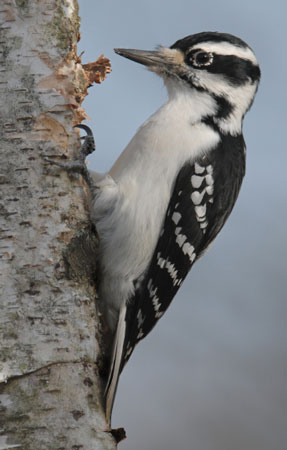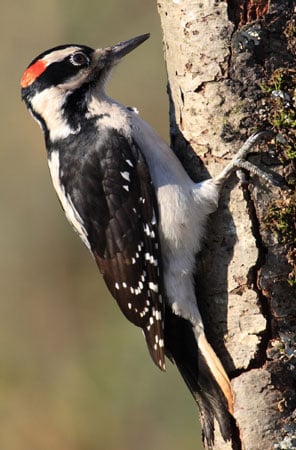Picoides villosus
For many people, seeing and enjoying woodpeckers is justification enough for feeding birds at a backyard feeder. Their distinctive forms compared to perching birds are easy to recognize. The contrasting black and white plumage is viewable without binoculars. Their clear vocalizations are easily heard. A favorite among favorites is the handsome, Hairy Woodpecker.
This non-migratory specie is found throughout the United States and Canada wherever woodlands and forest tracts are nearby. Its range even extends into Central America. As with other members of the woodpecker family, the primary food is insects. Hairy Woodpeckers readily come to bird feeders to supplement this diet with seeds. Traditionally, the big attractants have been suet and sunflower seeds. More recently, quality commercial mixes have included peanuts and tree nuts that have an equally strong appeal. The result is that this widespread woodpecker is easily attracted to birdfeeders.
Hairy Woodpeckers are denizens of the forest. They are most common in large and mature woods, but are also found in wooded suburbia. Nesting cavities are excavated in dead and declining trees with soft wood fibers. Much of their foraging for insects occurs on the trunks of trees as they hitch up and down probing cracks and crevices in the bark with their long bills. Protecting this beautiful woodpecker species is a good reason to encourage the preservation of forested landscapes. Loss of wooded tracts negatively impacts the populations of woodpecker species like the Hairy.
Hairy Woodpeckers even use trees to communicate! Drumming is a form of song substitution. They will find a resonant wood surface and with a steady, rapid cadence announce their presence to others of their kind. Males drum to let other males know they have laid claim to a territory. They will then drum to attract a female to the territory. Once a pair bond is formed, they drum to maintain contact as they forage separately. Leaving a dead snag in your woodlot may save your siding from being used as a sounding board!
A feeder filled with Aspen Song® Woodpecker Mix is just the kind of nutritious food supply Hairy Woodpeckers require. And their visits are not limited to winter months. It is a real treat to have a pair bring their young to the feeder in the summer months. The kids are typically stationed in nearby protective cover while the parents relay peanuts and other treats from the feeder to the demanding young. Another nature show right outside your window!
Reference
Jackson, Jerome A., Henri R. Ouellet and Bette J. Jackson. 2002. Hairy Woodpecker (Picoides villosus), The Birds of North America Online (A. Poole, Ed.). Ithaca: Cornell Lab of Ornithology.

